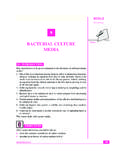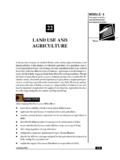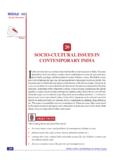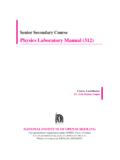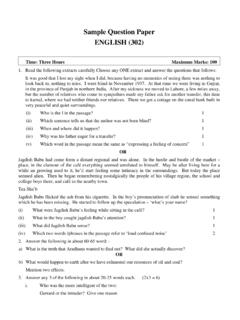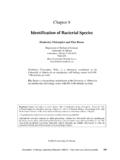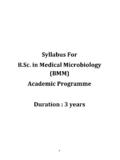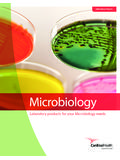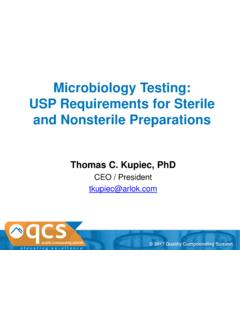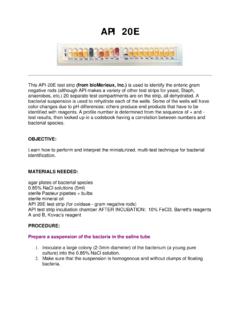Transcription of 11 BACTERIAL IDENTIFICATION TESTS - National …
1 MICROBIOLOGYMODULEB acterial IDENTIFICATION TestsMicrobiology 122 Notes11 BACTERIAL INTRODUCTIONIn the previous chapter we have discussed various methods of isolation ofbacteria. The bacteria thus isolated needs to be further identified to genus andspecies level. The IDENTIFICATION is required so as to cure the illness or theinfection caused due to the bacteria by using appropriate antibiotics. Identificationalso holds significance for epidemiological reading this chapter, you will be able to :zdescribe the processes involved in the IDENTIFICATION of the significance of microscopy in the process of IDENTIFICATION the significance of biochemical test in the process of identificationof the significance of serology in the process of IDENTIFICATION the significance of phage typing in the process of IDENTIFICATION the significance of antimicrobial susceptibility testing in the processof IDENTIFICATION of BACTERIAL IDENTIFICATIONThe isolated bacteria are further processed through one or few of the proceduresmentioned below so as to identify the bacteriazStaining
2 Of the isolated bacteriazMotility testing 123 BACTERIAL IDENTIFICATION TestsMICROBIOLOGYMODULEM icrobiologyNoteszBiochemical testingzSerological testszPhage typingzIdentification disc testingzSemiautomated and Automated IDENTIFICATION systemszMolecular techniques(i) Staining of the isolated bacteriaStaining of the bacteria forms the foremost and the most important step in theidentification of bacteria. The isolated bacteria are stained by various methodsdepending upon the bacteria in focus. Various staining techniques are as follow1. Gram staining: differentiates bacteria into two typesGram positive and Gram negative bacteriaGram positive bacteria can be either cocci or bacilli or vibrios.
3 Grampositive pathogenic bacteria are staphylococci, streptococci, pneumococci,etcGram negative bacteria can be either cocci or bacilli. Gram negativepathogenic bacteria commonly encountered are , Klebsiella, Salmonellaspp, shigella, etc2. Albert staining: is performed in case if one suspects a Acid fast staining: is performed in cases suspected of Mycobacterialinfection. Eg. Tuberculosis, leprosy, Special staining is necessary in case of spirochetes and other QUESTIONS .. of bacteria is the important step in IDENTIFICATION of bacteria2. Gram stain differentiates bacteria as.
4 & ..3.. staining is used in IDENTIFICATION of Corynebacterium spp4.. staining is used in IDENTIFICATION of Mycobacterial infection5.., .. & .. are examples of GramPositive Bacteria6.., .. & .. are examples of GramNegative BacteriaMICROBIOLOGYMODULEB acterial IDENTIFICATION TestsMicrobiology 124 Notes(ii) Motility testingMotility testing is performed by preparing a wet mount and is then observedunder the microscope. Motility of bacteria can also be tested by inoculating thebacteria in the semisolid motility medium.(iii) Biochemical testsThe staining is followed by use of various biochemical reagents and TESTS to getcloser to the IDENTIFICATION of bacteria.
5 There are many biochemical testsavailable for BACTERIAL IDENTIFICATION . Few of them are required to be carried outdepending upon the bacteria. The commonly used biochemical TESTS are asmentioned below(a) Catalase test(b) Coagulase test(c) Oxidase test(d) Sugar fermentation test(e) Indole test(f) Citrate test(g) Urease test(a) Catalase testPurposeThe catalase test facilitates the detection of the enzyme catalase in bacteria. Itis essential for differentiating catalase-positive Micrococcaceae from catalase-negative Streptococcaceae. While it is primarily useful in differentiating betweengenera, it is also valuable in speciation of certain gram positives suchas Aerococcus urinae (positive) from Aerococcus viridians (negative) and gram-negative organisms such as Campylobacter fetus, Campylobacter jejuni,and Campylobacter coli (all positive) from other Campylobacter :Place a microscope slide inside a petri dish.
6 Keep the petri dish cover a sterile inoculating loop or wooden applicator stick, collect a smallamount of organism from a well-isolated 18- to 24-hour colony and place it ontothe microscope slide. Be careful not to pick up any agar. This is particularlyimportant if the colony isolate was grown on agar containing red blood of red blood cells into the test may result in a false-positive a dropper or Pasteur pipette, place 1 drop of 3% H2O2 onto the organismon the microscope slide. Do not mix. Immediately cover the petri dish with a 125 BACTERIAL IDENTIFICATION TestsMICROBIOLOGYMODULEM icrobiologyNoteslid to limit aerosols and observe for immediate bubble formation (O2 + water= bubbles).
7 Observing for the formation of bubbles against a dark backgroundenhances positive bacteria: Staphylococcus sppCatalase negative bacteria: Streptococcus sppb. Coagulase testPurposeThe coagulase test differentiates strains of Staphylococcus aureus from othercoagulase-negative species. S. aureus strains are capable of coagulating plasmain the tube test and will produce clumps of cells in the slide coagulase test can be performed using two different procedures - Slide testand tube test. The slide test is simple, giving results within 10 seconds, but itcan give false negatives. The tube test is the definitive test, however, it can takeup to 24 hours to complete.
8 For both TESTS , clumping or clots of any size indicatea positive response. While S. aureus is the most commonly isolated coagulase-positive organism, there are several other species of Staphylococcus which arepositive for coagulase activity. S. schleiferi and S. lugdunensis may give positiveresults in the slide test for bound coagulase, and S. schleiferi and may give positive results in the tube coagulase test .Procedure:The slide test is performed by preparing a suspension of BACTERIAL cells mixedinto a drop of rabbit plasma on a microscope slide. If bound coagulase is presenton the BACTERIAL cells, then the presence of plasma will cause the BACTERIAL cellsto clump.
9 The clumping will occur because the clumping factor is an adhesin,which causes the cells to bind to fibrinogen in the plasma. This will result invisible clumping of BACTERIAL cells on the microscope slide. Figure given belowillustrates the visible clumping of cells on the microscope slide. MICROBIOLOGYMODULEB acterial IDENTIFICATION TestsMicrobiology 126 NotesFig. : Slide coagulase tube coagulase test is performed by mixing BACTERIAL cells into a largervolume of plasma in a small test tube. As the bacteria multiply in the plasma,they secrete staphylocoagulase. Staphylocoagulase initiates blood coagulationby activating prothrombin.
10 Staphylocoagulase adheres to fibrinogen, forming acomplex that cleaves fibrinogen into fibrin, bypassing the blood clotting cascadeand directly causing a clot of fibrin to form. Formation of a clot will be notedwithin 24 hours for a positive response. Figure shows a negative reaction anda positive : Tube coagulase positive bacteria: Staphylococcus aureusCoagulase negative bacteria: Staphylococcus epidermis, StaphylococcussaprophyticusINTEXT QUESTIONS of bacteria can be tested by inoculating the bacteria in .. test is primarily useful in differentiating between .. of catalase positive bacteria is.
